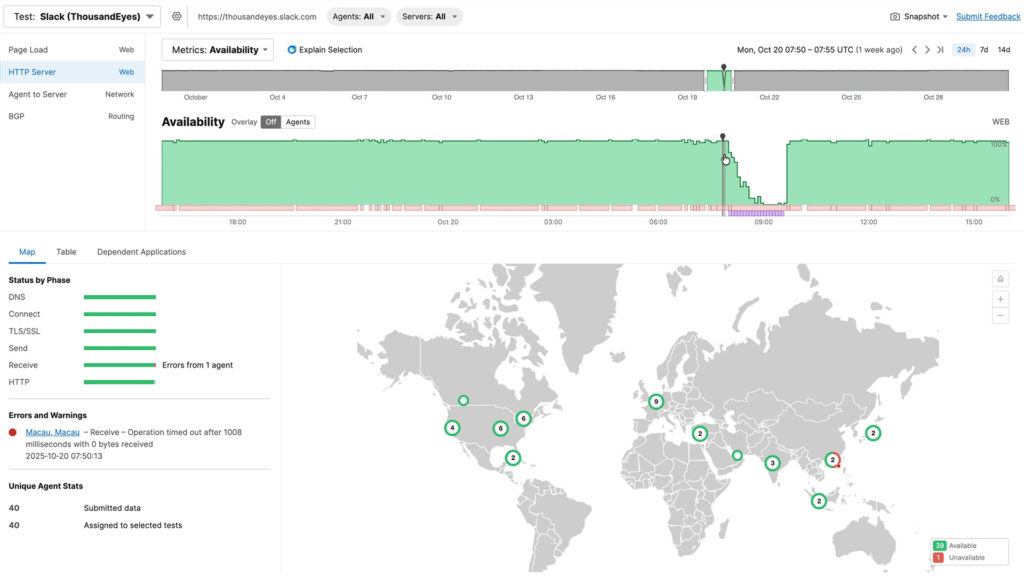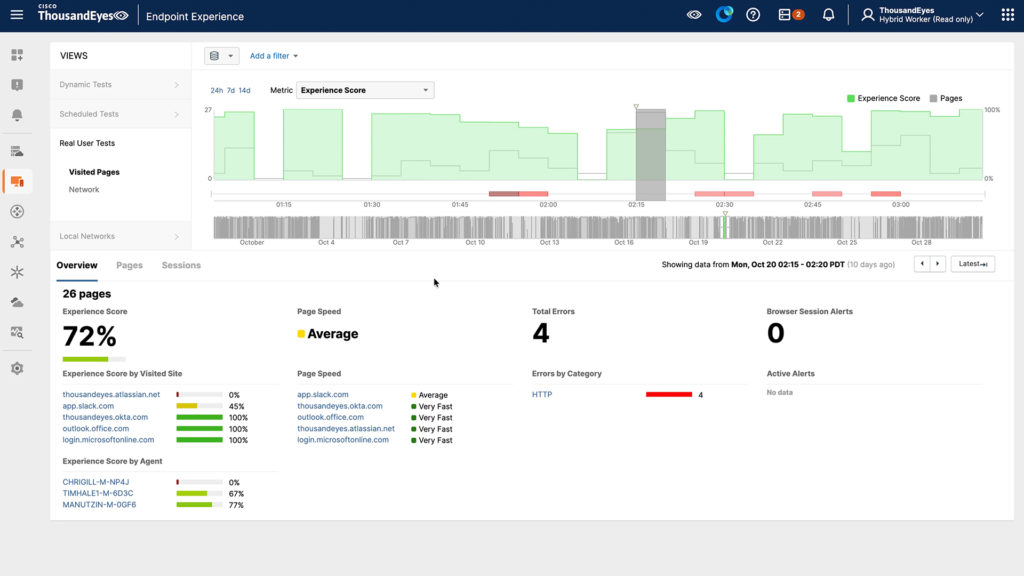The Wake-Up Call We All Felt
On October 20, 2025, organizations across industries, from banking to streaming, logistics to healthcare, experienced widespread service degradation when AWS’s US-EAST-1 region suffered a significant outage. As the ThousandEyes analysis revealed, the disruption stemmed from failures within AWS’s internal networking and DNS resolution systems that rippled through dependent services worldwide.
The root cause, a latent race condition in DynamoDB’s DNS management system, triggered cascading failures throughout interconnected cloud services. But here’s what separated teams that could respond effectively from those flying blind: actionable, multilayer visibility.
When the outage began at 6:49 a.m. UTC, sophisticated monitoring immediately revealed 292 affected interfaces across Amazon’s network, pinpointing Ashburn, Virginia as the epicenter. More critically, as conditions evolved, from initial packet loss to application-layer timeouts to HTTP 503 errors, comprehensive visibility distinguished between network issues and application problems. While surface metrics showed packet loss clearing by 7:55 a.m. UTC, deeper visibility revealed a different story: edge systems were alive but overwhelmed. ThousandEyes agents across 40 vantage points showed 480 Slack servers affected with timeouts and 5XX codes, yet packet loss and latency remained normal, proving this was an application issue, not a network problem.

Figure 1. Changing nature of symptoms impacting app.slack.com during the AWS outage
Endpoint data revealed app.slack.com experience scores of just 45% with 13-second redirects, while local network quality remained perfect at 100%. Without this multilayer insight, teams would waste precious incident time investigating the wrong layer of the stack.

Figure 2. app.slack.com observed for an end user
The recovery phase highlighted why comprehensive visibility matters beyond initial detection. Even after AWS restored DNS functionality around 9:05 a.m. UTC, the outage continued for hours as cascading failures rippled through dependent systems, EC2 couldn’t maintain state, causing new server launches to fail for 11 additional hours, while services like Redshift waited to recover and clear massive backlogs.
Understanding this cascading pattern prevented teams from repeatedly attempting the same fixes, instead recognizing they were in a recovery phase where each dependent system needed time to stabilize. This outage demonstrated three critical lessons: single points of failure hide in even the most redundant architectures (DNS, BGP), initial problems create long-tail impacts that persist after the first fix, and most importantly, multilayer visibility is nonnegotiable.
In today’s war rooms, the question isn’t whether you have monitoring, it’s whether your visibility is comprehensive enough to quickly answer where the problem is occurring (network, application, or endpoint), what the scope of impact is, why it’s happening (root cause vs. symptoms), and whether conditions are improving or degrading. Surface-level monitoring tells you something is wrong. Only deep, actionable visibility tells you what to do about it.
The event was a stark reminder of how interconnected and interdependent modern digital ecosystems have become. Applications today are powered by a dense web of microservices, APIs, databases, and control planes, many of which run atop the same cloud infrastructure. What appears as a single service outage often masks a far more intricate failure of interdependent components, revealing how invisible dependencies can quickly turn local disruptions into global impact.
Seeing What Matters: Assurance as the New Trust Fabric
At Cisco, we view Assurance as the connective tissue of digital resilience, working in concert with Observability and Security to give organizations the insight, context, and confidence to operate at machine speed. Assurance transforms data into understanding, bridging what’s observed with what’s trusted across every domain, owned and unowned. This “trust fabric” connects networks, clouds, and applications into a coherent picture of health, performance, and interdependency.
Visibility alone is no longer sufficient. Today’s distributed architectures generate a massive amount of telemetry, network data, logs, traces, and events, but without correlation and context, that data adds noise instead of clarity. Assurance is what translates complexity into confidence by connecting every signal across layers into a single operational truth.
During incidents like the October 20th outage, platforms such as Cisco ThousandEyes play a pivotal role by providing real-time, external visibility into how cloud services are behaving and how users are affected. Instead of waiting for status updates or piecing together logs, organizations can directly observe where failures occur and what their real-world impact is.
Key capabilities that enable this include:
- Global vantage point monitoring: Cisco ThousandEyes detects performance and reachability issues from the outside in, revealing whether degradation stems from your network, your provider, or somewhere in between.
- Network path visualization: It pinpoints where packets drop, where latency spikes, and whether routing anomalies originate in transit or within the cloud provider’s boundary.
- Application-layer synthetics: By testing APIs, SaaS applications, and DNS endpoints, teams can quantify user impact even when core systems appear “up.”
- Cloud dependency and topology mapping: Cisco ThousandEyes exposes the hidden service relationships that often go unnoticed until they fail.
- Historical replay and forensics: After the event, teams can analyze exactly when, where, and how degradation unfolded, transforming chaos into actionable insight for architecture and process improvements.
When integrated across networking, observability, and AI operations, Assurance becomes an orchestration layer. It allows teams to model interdependencies, validate automations, and coordinate remediation across multiple domains, from the data center to the cloud edge.
Together, these capabilities turn visibility into confidence, helping organizations isolate root causes, communicate clearly, and restore service faster.
How to Prepare for the Next “Inevitable” Outage
If the past few years have shown anything, it’s that large-scale cloud disruptions are not rare; they’re an operational certainty. The difference between chaos and control lies in preparation, and in having the right visibility and management foundation before crisis strikes.
Here are several practical steps every enterprise can take now:
- Map every dependency, especially the hidden ones.
Catalogue not only your direct cloud services but also the control plane systems (DNS, IAM, container registries, monitoring APIs) they rely on. This helps expose “shared fates” across workloads that appear independent. - Test your failover logic under stress.
Tabletop and live simulation exercises often reveal that failovers don’t behave as cleanly as intended. Validate synchronization, session persistence, and DNS propagation in controlled conditions before real crises hit. - Instrument from the outside in.
Internal telemetry and provider dashboards tell only part of the story. External, internet-scale monitoring ensures you know how your services appear to real users across geographies and ISPs. - Design for graceful degradation, not perfection.
True resilience is about maintaining partial service rather than going dark. Build applications that can temporarily shed non-critical features while preserving core transactions. - Integrate assurance into incident responses.
Make external visibility platforms part of your playbook from the first alert to final recovery validation. This eliminates guesswork and accelerates executive communication during crises. - Revisit your governance and investment assumptions.
Use incidents like this one to quantify your exposure: how many workloads depend on a single provider region? What is the potential revenue impact of a disruption? Then use those findings to inform spending on assurance, observability, and redundancy.
The goal isn’t to eliminate complexity; it’s to simplify it. Assurance platforms help teams continuously validate architectures, monitor dynamic dependencies, and make confident, data-driven decisions amid uncertainty.
Resilience at Machine Speed
The AWS outage underscored that our digital world now operates at machine speed, but trust must keep pace. Without the ability to validate what’s truly happening across clouds and networks, automation can act blindly, worsening the impact of an already fragile event.
That’s why the Cisco approach to Assurance as a trust fabric pairs machine speed with machine trust, empowering organizations to detect, decide, and act with confidence. By making complexity observable and actionable, Assurance allows teams to automate safely, recover intelligently, and adapt continuously.
Outages will continue to happen. But with the right visibility, intelligence, and assurance capabilities in place, their consequences don’t have to define your business.
Let’s build digital operations that are not only fast, but trusted, transparent, and ready for whatever comes next.

